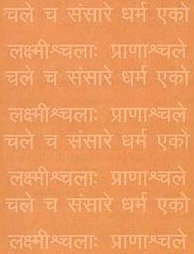Shriharsha, Śrīharṣa, Sriharsha: 7 definitions
Introduction:
Shriharsha means something in Hinduism, Sanskrit, the history of ancient India. If you want to know the exact meaning, history, etymology or English translation of this term then check out the descriptions on this page. Add your comment or reference to a book if you want to contribute to this summary article.
The Sanskrit term Śrīharṣa can be transliterated into English as Sriharsa or Shriharsha, using the IAST transliteration scheme (?).
In Hinduism
Vedanta (school of philosophy)
Source: Hindupedia: Later AdvaitinsŚrīharṣa, c. 12th century CE, wrote the Khaṇḍana-khaṇḍa-khādya, considered to be one of the most difficult works in Advaita-Vedanta. The difficulty arises partly due to the extensive use of destructive dialectical methods to demolish dualistic views, and partly due to complicated Sanskrit language constructions. His other well-known work is the Naiśāda-carita, based on the story of Nala and Damayantī.

Vedanta (वेदान्त, vedānta) refers to a school of orthodox Hindu philosophy (astika), drawing its subject-matter from the Upanishads. There are a number of sub-schools of Vedanta, however all of them expound on the basic teaching of the ultimate reality (brahman) and liberation (moksha) of the individual soul (atman).
General definition (in Hinduism)
Source: Oxford Reference: A Dictionary of Hinduism(12th century ce) A Śaṅkaran Advaita Vedāntin who was a trenchant critic of the Nyāya interpretation of the pramāṇas.
India history and geography
Source: Shodhganga: a concise history of Sanskrit Chanda literature (history)Śrīharṣa (श्रीहर्ष) is the name of a renowned scholar according to Dhīreśvarācārya (1851-1919 C.E.): a poet of modern Assam who composed Vṛttamañjarī. Dhīreśvarācārya says Śrīharṣa, a renowned scholar in the fields of Philosophy, Sāṃkhya, Yoga, Nyāya, Vaiśeṣika, Mīmāṃsā, Vedānta and acknowledged by many learned scholars and poets was the gotrapravartaka of the family of the poet.

The history of India traces the identification of countries, villages, towns and other regions of India, as well as mythology, zoology, royal dynasties, rulers, tribes, local festivities and traditions and regional languages. Ancient India enjoyed religious freedom and encourages the path of Dharma, a concept common to Buddhism, Hinduism, and Jainism.
Languages of India and abroad
Sanskrit dictionary
Source: Cologne Digital Sanskrit Dictionaries: Cappeller Sanskrit-English DictionaryŚrīharṣa (श्रीहर्ष).—[masculine] [Name] of a royal author.
Source: Cologne Digital Sanskrit Dictionaries: Aufrecht Catalogus Catalogorum1) Śrīharṣa (श्रीहर्ष) as mentioned in Aufrecht’s Catalogus Catalogorum:—See Harsha and Harshakīrti.
2) Śrīharṣa (श्रीहर्ष):—Jānakīgīta.
3) Śrīharṣa (श्रीहर्ष):—Śrīphalavardhinī Nīlakaṇṭhīṭīkā jy.
4) Śrīharṣa (श्रीहर्ष):—son of Hīra. His works are given on p. 763.
5) Śrīharṣa (श्रीहर्ष):—Mantrārthadīpikā [tantric]
6) Śrīharṣa (श्रीहर्ष):—son of Hīra: Dvirūpakośa. See Śabdabhedaprakāśa.
Source: Cologne Digital Sanskrit Dictionaries: Monier-Williams Sanskrit-English DictionaryŚrīharṣa (श्रीहर्ष):—[=śrī-harṣa] [from śrī] m. Name of various authors etc. ([especially] of a celebrated king and poet or patron of poets, also called Śrīharṣa-kavi or Śrī-harṣa-deva, who lived probably in the first half of the seventh century A.D. and is the supposed author of three plays, viz. Nāgānanda, Priya-darśikā, and Ratnāvalī).
[Sanskrit to German]
Sanskrit, also spelled संस्कृतम् (saṃskṛtam), is an ancient language of India commonly seen as the grandmother of the Indo-European language family (even English!). Closely allied with Prakrit and Pali, Sanskrit is more exhaustive in both grammar and terms and has the most extensive collection of literature in the world, greatly surpassing its sister-languages Greek and Latin.
See also (Relevant definitions)
Partial matches: Harsha, Shri.
Starts with: Shriharshadeva, Shriharshakhandana.
Full-text (+16): Mamalladevi, Navasahasankacarita, Bhandi, Mahakavya, Harsha, Naishadha, Shri harsha, Dikshita shri harsha, Khandana-khanda-khadya, Janakigita, Nagananda, Shlesharthapadasamgraha, Ratnavali, Pratilambha, Tamisrapaksha, Kaviraja, Mahakavi, Anirvacaniyasarvasva, Hira, Haravarsha.
Relevant text
Search found 30 books and stories containing Shriharsha, Shri-harsha, Śrī-harṣa, Sri-harsa, Śrīharṣa, Sriharsa, Sriharsha; (plurals include: Shriharshas, harshas, harṣas, harsas, Śrīharṣas, Sriharsas, Sriharshas). You can also click to the full overview containing English textual excerpts. Below are direct links for the most relevant articles:
Amarakoshodghatana of Kshirasvamin (study) (by A. Yamuna Devi)
Diseases and Impurities < [Chapter 3 - Social Aspects]
Amarakośodghāṭana (Introduction) < [Chapter 2 - Kṣīrasvāmin: Life and Works]
Introduction (Kośa Literature–A Brief Survey) < [Chapter 1 - Kośa Literature–A Brief Survey]
Naishadha-charita of Shriharsha (by Krishna Kanta Handiqui)
Introduction to Śrīharṣa’s Naiṣadhacarita < [Introduction]
Introduction to Vidyādhara’s commentary < [Introduction]
A History of Indian Philosophy Volume 2 (by Surendranath Dasgupta)
Part 17 - Application of the Dialectic to the Different Categories and Concepts < [Chapter XI - The Śaṅkara School of Vedānta (continued)]
Part 16 - Vedānta Dialectic of Śrīharṣa (a.d. 1150) < [Chapter XI - The Śaṅkara School of Vedānta (continued)]
Part 19 - The Dialectic of Nāgārjuna and the Vedānta Dialectic < [Chapter XI - The Śaṅkara School of Vedānta (continued)]
Impact of Vedic Culture on Society (by Kaushik Acharya)
Mingling of Cultures (I): The Puṣyabhūtis < [Chapter 4]
Chart: Religious beliefs of the Kings who ruled in Northern India < [Chapter 4]
Sanskrit Inscriptions (F): The Early Gurjaras < [Chapter 3]
Atithi or Guest Reception (study) (by Sarika. P.)
Part 5 - References to Hospitality in the Naiṣadhīyacarita < [Chapter 4 - Atithi-saparyā in Classical Sanskrit Literature]
Nyayakusumanjali of Udayana (study) (by Sri Ramen Bhadra)
Udayana: Personal History < [Chapter 1 - Introduction]
Related products
